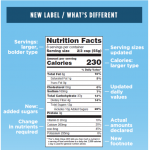The Nutrition Facts label, seen on packaged bags, boxes, cans, etc., is the consumer information gateway to making healthy choices for ourselves and our families. But let’s face it, for many Americans, interpreting the Nutrition Facts label can be downright confusing, at times, essentially clouding our decision-making abilities.
Facts label, seen on packaged bags, boxes, cans, etc., is the consumer information gateway to making healthy choices for ourselves and our families. But let’s face it, for many Americans, interpreting the Nutrition Facts label can be downright confusing, at times, essentially clouding our decision-making abilities.
Making informed decisions about what you eat every day is an important step in maintaining good nutrition, reducing your risk for heart disease, and keeping your weight in a healthy range. After more than 20 years, the FDA has finalized an improved version of the old label to be in full effect nationwide by mid-2018. First Lady Michelle Obama states, “This is going to make a real difference in providing families across the country the information they need to make healthy choices.”
Key Changes to Look For on the New Label: 
- Added Sugars – One of the more important changes is based on data that shows the difficulty in meeting nutrient needs while staying within calorie limits if you consume more than 10 percent of your total daily calories from added sugar.
- Specific Vitamins & Minerals – Vitamin D and potassium will be required on the label. Calcium and iron will continue to be required. Vitamins A and C will no longer be required but can be included on a voluntary basis.
- Daily Values (%) – Updates on sodium, dietary fiber, and Vitamin D.
- Serving Sizes – Now reflect actual common amounts consumed, not recommended amounts. For example, a serving size for soda previously was 8oz. but is now 12oz.
 Package Size – Calories and other nutrients will be required to be labeled as one serving because people typically consume it in one sitting.
Package Size – Calories and other nutrients will be required to be labeled as one serving because people typically consume it in one sitting.
- New Format – Highlighting “Calories,” “Servings per container,” and the “Serving size” declaration by increasing the type size and placing the number of calories and the “Serving size” declaration in bold type as well as changing the footnote to better explain the percent Daily Value.
The new label regulations apply to packaged foods except certain meat, poultry, and processed egg products, which are regulated by the U.S. Department of Agriculture’s Food Safety and Inspection Service. To learn more about these important changes, visit the Food and Drug Administration website and read Changes to the Nutrition Facts Label.
 0
0
